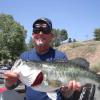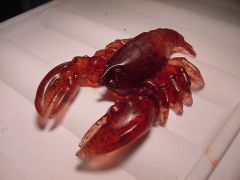-
Posts
14,742 -
Joined
-
Last visited
-
Days Won
365
Content Type
Profiles
Articles
TU Classifieds
Glossary
Website Links
Forums
Gallery
Store
Everything posted by mark poulson
-
Double round over bits are very common. Just go to a woodworking store, or site online. Piloted carbide bits are the way to go. Shape your lure, sand it smooth on the edge, and set the bit so you keep a little of the smooth to ride the pilot on. I prefer 1/4 round bits, so I can use the actual lure for the pattern, instead of having to attach a pattern. But if you're into production, the pattern and 1/2 round bit could be the way to go.
-
For gliders, weight them so they float horizontal with the front 1/3+- out of the water. Make the bait, seal it, install the hook hangers and eye tie, put on the split rings and hooks, and then float it in a bucket of water. Add weight until it floats right. Generally speaking, add the weight toward the tail for a glider, and toward the middle just past the mid point for a walking bait. 6" gliders with less weight, so 1/2 of the front is out of the water, will also walk the dog really well. Making a 9" walk will kill you in five minutes. Good luck.
-
I think (dangerous, I know) that the water moving past the sides of the swimbait creates the movement, as the water hitting the joints deflects, like a sail, and makes the water swirl as it passes the bait. The pieces are pulled to one side or the other, and once the bait starts to move, the water forces each piece back the other way. A vicious cycle, kind of. I also have a BBZ1 floater, and have caught a lot of fish on it. It shines in the spawn and post spawn, when the bass are most aggressive or have their feed bag on. I can't burn it as fast as a triple trout, so I don't throw it as a reaction bait in the wind. I'll post a picture as soon as I can. I did find out that coating the faces of the joints separately from the main body is a bad idea. The epoxy peeled off the joint faces. I'm going to dig the hinge pins out, re coat the pieces completely using the coat hanger trick posted here earlier today, and then, when it's reassembled, I'll photo it and post it, if I can. Pete, I am not making these to sell, but it is a very compelling hobby. I used to make my own shakey heads, and paint them, but this is way more addicting. And fun. RM, If it's any consolation, last Friday I was a voluteer observer at the first Heavyweight Bass Classic, put on by Ron Cervanka, John Barron, and Ken Huddleston (the swimbait guy) at Lake Casitas in Ojai, CA. One angler and one observer per boat, 50 boats, $200 buy in, $10,000 winner take all for biggest fish. Almost all of the best big fish guys from California, North and South, were there. At safe light launch, it was 40+degrees, 20mph winds, and light rain. That developed during the day to 40- degrees, 35-30mph winds, driving rain and hail. I was never so happy for 2:45 second flight weighin to come! Seven+ hours standing in the back of the boat, watching someone else fish in lousy weather, and a tough bite (Floridas don't like cold fronts) was miserable. My angler caught eight fish, fished hard all day, and had a 10+ follower on a swimbait early, but his biggest was 3.71lbs. The winner was Don Osborne, from NoCal, throwing a 12" Castaic swimbait. He stuck a 10.5lb beauty. He said he caught it on his first cast, third crank of the reel. He also said he'd called the lake and found out that they were planting 12" trout. No one else threw a 12" bait. Sharp guy. Anyway, it was cold, but not snowing. My friend was an angler and was the leader in the hot seat for 45 minutes with a 7+lb jig fish, until Don weighed in. He said at one point his boat was white with hail. That's cold enough for me.
-
Hand held routers with piloted bits are much safer than router table, which are just small shapers. At least, with your hands on the router, you fingers are up and out of the way. I've seen shaper throw materials 50' in a shop. Router tables, while smaller, can still throw a piece of wood back into you with penetrating force. Read spear or arrow. As was stated earlier, ALWAYS feed against the rotation of the bit, so the cutter is coming toward the work, or you will have the work snatched out of your hand and hurled somewhere you don't want it to go. And always use sharp bit. Nothing is more dangerous than a dull tool.
-
Great idea! I'm definately going to try that.
-
I threw my triple fish copy yesterday at Lake Castaic in SoCal, in a rainstorm, and caught my first fish on it, a 6.77 beauty. What a thrill! I've caught bigger fish, but this is the biggest on one of my home made lures, and the first on one of my jointed baits. I am waiting for my friend to email me the photo, and then I'll try to post it (no promises, you know I'm internet illiterate). The lure is a 7" had body, 4 section, with a 2" triple trout tail, painted in pearl silver/ med green back/misted with pink fuchsia, and larger black spots. It floats almost completely submerged, and doesn't roll, even on a fast retrieve. I was using a med. fast retrieve, throwing it tight to rock walls and points. I caught the fish on a wind blown point. I was fishing yesterday because I am the weighmaster for Mike Iljin's Angler's Choice Castaic Trial, and I fish for fun after launch and before weighin. I was stoked. Bill Siemental and Troy Lindner won the tournament. Bill said he was throwing swimbaits, and Troy was "doing other stuff". They won big fish with a 6.5 lb swimbait fish, so my fish was bigger. What a kick!
-
I only use round split rings for my hooks. I'd be afraid that the oval rings might bind if they get sideways during the cast. I use oval split rings on the line ties of my jerkbaits. I think it increases the action. I don't know why, but I always seem to hang my line on the split when I'm tying on, so I have to go really slowly. With regular split rings, I am in the habit of just turning them before I draw down the knot, but oval rings seem to reach out and grab my line. But I still use them.
-
Michael's sells some spray-on glitter in rattle cans that sticks when it's sprayed, and doesn't move when you clearcoat with Etex. Silver, gold, and mixed.
-
Maypo, You're a clever devil! Who'da thunk it? Hemostats and magnets! It's a great setup. If you make bigger baits, you can cut a couple of plywood wheels, mount them on your shaft, and suspend the baits between the wheels to dry them.
-
I think KcDano is right. Clear it with epoxy. The texture just adds to the lures footprint in the water, and makes it unique.
-
I did a mr max search and came up empty. Am I using the wrong bait? )
-
Room temp, 70 degrees+-, is what hobby epoxies, and that includes Devcon, were designed to cure out in. Colder than that slows them down. Much warmer than that can lead to other problems, like BobP said.
-
-
Take it to a local gym, and just tell the person at the desk that you want to take your 12 incher for a swim. Be sure no one else is in the pool. It's important to test with the hooks on. My son's friend is a lifeguard at the local YMCA, so I can do testing there if it's slow. All it costs me is a ton of food everytime he comes over. Bottomless pit!
-
If you screw up a lip slot, stop, cut a dutchman (a small, snug fitting piece of wood), and glue it in the bad slot. When the glue sets, it'll be ready to cut again. The exterior wood glues available today, like Gorilla Glue, or Tightbond 2, are so strong if you make a good fit, that the wood will fail before the glue. Remember, if it's made from wood, it can be fixed.
-
Always cut away from yourself, and make sure your hand tools are sharp. And don't rush. Just like life in general, it's the journey, not the destination.
-
I looked at the Barlow's springs, and I agree with Bruce. They look too small for larger plastics. You can make your own by wrapping some spinnerbait wire around a 3/8" lag screw. That makes a coarse spring that works well for swimbait tails.
-
I let my wheel turn all night. The Etex is still slightly tacky in the morning when I turn the wheel off. I don't really handle it until 24hrs have passed. I don't know the exact cure time. It probably varies, depending on temperature. Go to the Envirotex website, and email Hilary Stephens there. She's their tech person, and can answer any questions you have. hstephens@eti-usa.com
-
Do you paint the lure lying on a flat surface? How do you hold the frame in place?
-
Jed, I meant the relieved area immediately behind the rear hook. As soon as you mentioned tail action, I figured out it must be relieved to give the back hook more room to swing. Beautiful lures.
-
I use something like the blue part of the bobber stoppers Dinkmaster posted. After I screw my hitchhiker into the ribbit, and clip it onto the hook eye, I slip the bobber stopper onto the point, and push it around until it's just past the bend. Then I texpose the hook through the ribbit's bottom, and push the bobber stopper back down around the bend until it snugs up against the underside of the ribbits bottom. I push it up until the ribbit has a sway back a little. That seems to force the nose up so it swims right side up without adding any weight, and it also makes the legs a little more active, since they're forced up as well.
-
Clemmy, This is getting pretty deep. Better break the rubber boots. Next thing you'll tell me the motion causes morning sickness. )
-
Jed, How does the "scallop" of the bait behind the last hook hanger affect the bait?
-
Bruce, That's great! My older kids go out with me now when they're visiting (probably afraid to miss the chance before I croak), but my soon-to-be 13 year old daughter, who used to go, says she hates fishing, and will never set foot on the boat again. I guess I'll have to wait until she goes to college before she'll go out again.
-
I read somewhere that a short piece of the fiber optic cable is glued into a through hole, from one side of the bait to the other, to allow passage of light through it, creating a shifting eye flash. I read it, but I haven't done it.




